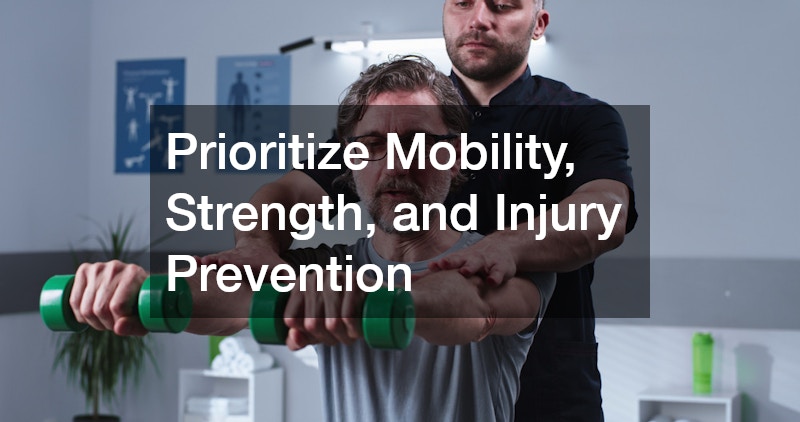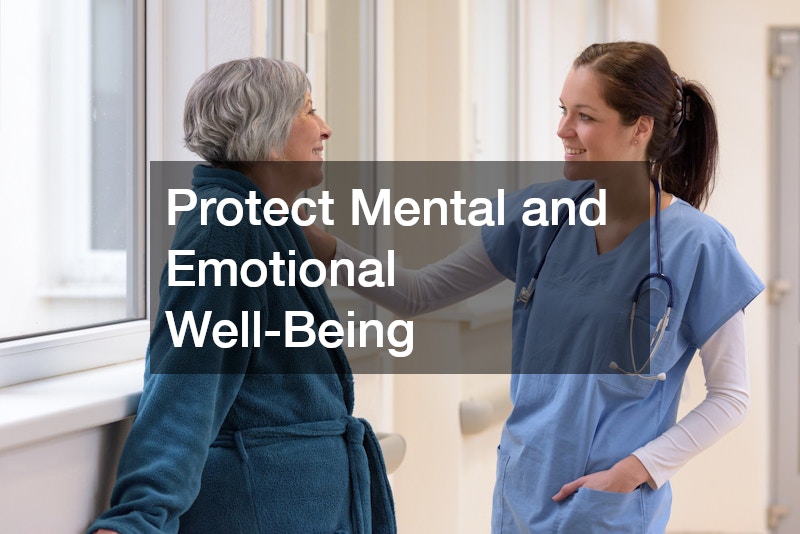Navigating health in midlife is a complex and often emotional experience. Bodies change, daily responsibilities expand, and long-term planning becomes more important than ever. Many people realize that the habits and choices that once felt automatic now require more intentional care. Midlife often coincides with major transitions—career shifts, evolving family roles, and new physical limitations—and these changes can influence both lifestyle and wellness.
This stage of life is also a time when proactive decisions create long-lasting benefits. Thoughtful planning, early intervention, and consistent preventive care can reduce stress and support independence well into later years. Whether you are managing your own health or supporting aging loved ones, understanding how to respond to medical concerns, maintain mobility, and prepare for future care needs can make this season far more manageable.
This guide explores practical strategies to help you stay healthy, informed, and confident during midlife and beyond. It offers clear advice for managing sudden health issues, building long-term wellness habits, supporting emotional well-being, and planning for the future—all with the goal of helping you maintain both quality of life and peace of mind.
Act Quickly When Sudden Health Issues Arise

Know When Immediate Care Is Necessary
Knowing when to seek immediate medical help is a critical part of staying safe in midlife. Symptoms like chest pain, sudden weakness, shortness of breath, or unexpected bleeding require prompt evaluation, and understanding where to go can save valuable time. Facilities equipped to treat non-life-threatening problems can offer rapid assessment, shorter wait times, and convenient access—all of which are extremely helpful when a sudden issue arises. These centers often deliver diagnostic tests, injury care, and preventive treatment in a streamlined setting. Being familiar with nearby providers and the services they offer allows you to make faster decisions during emergencies and ensures you can address new health concerns with confidence. Many people also keep a list of their medications, allergies, and existing conditions readily available so that health professionals can provide accurate, timely support in a stressful moment. This is especially useful when visiting urgent care, where clear information can significantly speed up your evaluation.
Being prepared also means having an organized personal health history. Keep a document—digital or printed—that lists your medications, allergies, chronic conditions, and recent test results. Share copies with trusted family members so someone can provide accurate information on your behalf if needed. Practicing simple drills, such as how to respond if you feel dizzy or injured, can also help you act quickly under stress.
Prepare for Unexpected Injuries
Recovering from unexpected injuries in midlife often requires a combination of immediate attention and proper follow-up care. Whether you’re dealing with a fall, strain, or collision-related injury, having a plan in place helps minimize pain and supports a smoother recovery. Keeping emergency contacts updated, creating a folder with medical information, and knowing which specialists handle different types of injuries can all make a difficult situation easier to manage. It’s also helpful to understand what specialized medical resources can offer after accidental injuries, especially when dealing with neck, back, or mobility concerns that can arise suddenly. Services designed for injury-related assessments deliver targeted care that helps identify internal damage, guide next steps, and prevent long-term complications. Preparing in advance—before an emergency occurs—ensures you can respond effectively and reduces the emotional burden of navigating urgent situations. Specialized providers like an auto accident medical service can streamline care after collisions and help you return to normal daily activities more safely.
It’s equally helpful to evaluate your home for potential hazards that could contribute to injuries. Midlife adults often underestimate risks like loose rugs, dim lighting, obstructed hallways, or slippery surfaces. Making targeted improvements can prevent many common accidents. Creating a rotation schedule for checking smoke alarms, first-aid supplies, and emergency contacts provides a sense of preparedness and reduces panic in unexpected circumstances.
Prioritize Mobility, Strength, and Injury Prevention

Build a Personalized Movement Routine
Maintaining joint stability, muscle strength, and overall flexibility becomes increasingly important during midlife, especially as the body becomes more sensitive to prolonged sitting or repetitive motions. Building a movement routine that includes stretching, balance work, and low-impact strength training can significantly reduce pain and improve everyday function. It often helps to start with small, manageable goals—such as a short morning stretch routine or walking for 15 minutes a day—before gradually increasing intensity. Many people also benefit from professional guidance when creating these routines, particularly if they experience pain, stiffness, or recurring injuries. Experienced clinicians can identify weak points and recommend specific exercises that support proper posture and reduce strain. Working with a physical therapist can provide a customized plan that enhances mobility and helps prevent future injury as the body continues to change with age.
Incorporating balance exercises into your routine is especially valuable in midlife. Simple movements—standing on one foot, slow controlled steps, or heel-to-toe walking—can strengthen stabilizing muscles that protect you from falls. Many people also experiment with low-impact activities such as tai chi, Pilates, or swimming, which support long-term joint health.
Reduce Musculoskeletal Stress at Home and Work
Everyday movements and habits often play a large role in midlife aches and strains. Adjusting your home and work environments can help minimize discomfort and prevent long-term musculoskeletal issues. Simple changes like switching to supportive footwear, setting up ergonomically correct workstations, and taking regular stretch breaks can significantly improve comfort. Additionally, organizing your home to reduce bending, reaching, and heavy lifting can reduce stress on the joints and spine. Tools such as grab bars, non-slip mats, and raised seating can make daily tasks much safer, especially for individuals managing chronic pain or reduced mobility. These small adjustments can offer major long-term benefits and help maintain independence. Many families also consider adapting their homes as loved ones age to improve safety and reduce physical strain, similar to the modifications seen in assistance living for seniors.
Consider reevaluating your daily habits through the lens of body mechanics. How you get in and out of a car, lift grocery bags, or reach for items on high shelves can affect long-term physical comfort. Learning safer techniques, such as using your legs rather than your back when lifting, can significantly reduce the likelihood of strain. Small adjustments to routine behaviors often add up to meaningful pain reduction over time.
Create a Long-Term Care Strategy Before You Need It

Research Housing and Care Options Early
Midlife is the ideal time to begin exploring long-term housing and care options, even if you feel healthy today. Planning ahead helps avoid rushed decisions later and provides clarity about what you want your future to look like. This process might include assessing your current home for safety, considering future mobility needs, and exploring different residential care models. Understanding the levels of support available—from minimal daily assistance to specialized care—can help you choose the best environment for long-term comfort and independence. Learning the difference between home care, community-based programs, and residential support options also helps you prepare financially and emotionally for the years ahead. When individuals start researching early, they’re far more likely to find an option that truly suits their lifestyle and values. Many people begin this research by touring communities and reviewing the services offered at assisted living residences.
Financial planning should also be part of your long-term strategy. Understanding insurance options, savings needs, and potential costs associated with future care enables you to make decisions without financial pressure. Midlife is an ideal time to meet with financial planners or legal professionals to discuss living wills, medical directives, and estate planning—all essential steps for preserving autonomy.
Get Professional Guidance When Comparing Care Models
Evaluating long-term care choices can feel overwhelming, especially when considering factors like cost, medical support, lifestyle preferences, and proximity to loved ones. Instead of navigating these decisions alone, many families turn to professionals who specialize in helping older adults and their families plan for the future. These experts provide insights into available care levels, financial planning considerations, and differences between housing types. They can also help assess whether a person may eventually need specialized cognitive care or mobility support. This guidance is especially valuable when families feel uncertain or emotionally strained by the process. Having access to someone knowledgeable about aging care ensures you understand your options and can make decisions confidently. Individuals seeking direction as they explore various care environments often consult a senior living advisor for personalized, informed recommendations.
Protect Mental and Emotional Well-Being

Recognize When Outside Support Is Needed
Midlife often brings emotional challenges that can catch people off guard—stress related to finances, caregiving responsibilities, career changes, or chronic health concerns. Recognizing when additional support is needed can prevent these pressures from building into something more serious. Common signs that professional help may be beneficial include persistent sadness, irritability, difficulty concentrating, sleep disruptions, or feeling overwhelmed by daily responsibilities. Seeking support early can make a meaningful difference in overall well-being. Many individuals find it helpful to create comforting routines, practice stress-management techniques, or engage in mindfulness activities such as journaling or yoga. However, professional guidance is sometimes necessary when emotions feel unmanageable or when stress interferes with relationships or daily functioning. Reaching out to a counseling center can provide access to therapists who specialize in helping adults navigate these midlife stressors.
Address Cognitive Changes Early
Cognitive changes—such as mild forgetfulness, trouble multitasking, or slower information processing—are common as people enter midlife, but they should not be ignored. Identifying these changes early allows individuals to take proactive steps to maintain brain health and slow potential decline. Activities that challenge the mind, including puzzles, reading, learning new skills, or engaging in stimulating conversations, can help keep cognitive function strong. It’s also important to consider lifestyle habits such as sleep quality, hydration, physical activity, and nutrition, all of which influence brain performance. When changes become more noticeable or begin affecting daily life, professional evaluation is important. Early assessment ensures that treatable conditions are not overlooked and helps individuals access support services. Families seeking specialized cognitive care or greater supervision for a loved one often explore options like a memory care facility, which provides structured programs designed to support cognitive health and safety.
Support Healthy Aging With Helpful Tools and Technology
Leverage Assistive Devices for Better Daily Function
Technology and assistive tools now play a major role in supporting independence during midlife and beyond. Devices designed to improve mobility, reduce safety risks, or enhance communication can significantly elevate daily quality of life. For example, wearable activity trackers encourage movement, smart home devices simplify routine tasks, and mobility aids help reduce fall risks. Supporting vision and hearing also becomes increasingly important, as sensory changes can affect safety, social participation, and cognitive health. Modern devices can dramatically improve clarity and comfort for individuals experiencing hearing-related challenges, enabling them to stay connected with family and maintain active lifestyles. Many people find that adopting tools early not only boosts confidence but also reduces frustration and improves their ability to stay engaged socially and professionally. For those experiencing auditory changes, considering hearing aids can provide essential support for communication and overall well-being.
Tour Local Care Resources in Your Community
Knowing what health and wellness resources exist in your community can help you make informed decisions long before a crisis arises. Many individuals begin by creating a list of local programs, wellness centers, home-care services, and community organizations that offer support for midlife and older adults. Touring facilities, speaking with staff, and learning about available services can help you understand the level of support offered and identify which resources might be helpful in the future. These visits also allow you to compare environments, ask questions, and evaluate how each option aligns with your needs or the needs of loved ones. Making these connections early provides peace of mind and ensures you have trustworthy, accessible options when changes in health occur. Many families begin this process by visiting nearby residences that offer supportive environments similar to local assisted living communities.
Midlife is a powerful turning point—one where thoughtful planning and proactive habits make an enormous difference in long-term well-being. By recognizing how your needs are changing, responding quickly to health concerns, and taking steps to protect your physical and emotional health, you set the foundation for a safer, more confident future. Preparing early, staying informed, and seeking support when needed allows you to navigate this phase of life with stability and clarity. With the right strategies in place, you can move through midlife and beyond with strength, independence, and peace of mind.





